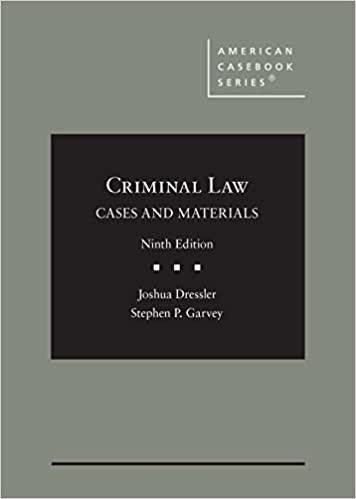Question
Hello I was just wondering if you could please peer edit this and add or cut anything that would make this case brief better. Thank
Hello I was just wondering if you could please peer edit this and add or cut anything that would make this case brief better. Thank you!
FACTS: On January 10th, 2000, Frederick France and Samuel Morris were both shot outside a mall in Southfield Michigan. The shots wounded France and killed Morris. France recovered from the injuries and was able to testify. France explained to the police that a group of men got into a van and pulled up besides them before the man sitting in the passengers seat pulled out a gun and shot inside Morris's car. The two suspects were Eric Purifoy and Van Chester Thompkins. Purifoy was arrested and charged with murder and assault. Thompkins on the other hand, fled until February 19, 2001. Three days after Thompkins arrest he was interrogated in a jail in Ohio. Detective Helgert presented Thompkins with a form from the Miranda rule asking him to read and sign the form to demonstrate that he understood his rights. Thompkins did not sign the form but did verbally agree to understanding his rights. During the interrogation Thompkins was very quiet and would only reply in one worded answers. Hours later detective Helgert asked if Thompkins believed in God and asked "Do you pray to God to forgive you for shooting that boy down?" Thompkins with tears in his eyes replied, "yes". Thompkins refused to make a written confession and was charged with first degree murder, assault and certain firearms-related offenses. He argued that he had invoked his fifth amendment. The trail court denied the motion ruling that he did not invoke his right to remain silent. At trail the prosecutions theory was that Thompkins shot the victims from the passenger seat. Purifoy testified that he had been driving and that Thompkins was in the passenger seat while Myzell Woodward, was in the back. Purifoy also explained that he did not see who fired the weapon because the van was stopped and he was bent over near the floor when the shots were fired. Purifoy and Detective Helgert testified that a jury acquitted him for the murder and assault charges, convicted him of carrying a concealed weapon, and hung on two other firearms offenses to which he pleaded guilty. On appeal in 2004 the Michigan court of appeals affirmed Thompkins sentence rejecting his claim of ineffective violation of his Miranda rights. The U.S. District court of Michigan denied Thompkins application for a writ of habeas corpus. However, in 2006 the Court of Appeals for the Sixth Circuit reversed and granted Thompkins motions on the miranda and ineffectiveness claims meaning the Michigan court of appeals applied the law in a unreasonable manner. In September 2009 the state of Michigan and Mary Burghuis appealed to the supreme court, granting certiorari.
ISSUES: Did the 6th Circuit fail to give the state court deference when the court granted habeas corpus relief with respect to defendant's unsuccessful counsel argument when there is evidence of the defendants guilt?
Did the 6th Circuit improperly expand the Miranda rule when it held that defendant's fifth amendment rights were violated?
HOLDING: Yes, the sixth circuit did fail to give the state court deference when the court granted habeas corpus relief with respect to defendant's unsuccessful counsel argument when there is evidence of the defendants guilt.
Yes, the 6th Circuit improperly expanded the Miranda rule when it held that defendant's fifth amendment rights were violated.
COURT'S REASONING:
1) Yes, the court held that even if the counsel for Thompkins was not effective that he can't prove that the was prejudiced by the counsels bad performance. It would have been a prerequisite to the foundation that his sixth amendment right was violated.
2) Yes, the defendants rights were fifth amendment rights were denied because of the refusal to sign that he knew his rights, but the defendant did verbally state that he knew the Miranda rights. The court stated how he did waive his right to remain silent by continuously responding to the detective.
CONCURRENCES: There were no concurrences.
DISSENTS: The dissenting opinion was Justice Sotomayor, Justice Stevens, Justice Ginsburg, and Justice Breyer. They reprimanded the majority for retreating the protections of the Miranda laws. Justice Sotomayor stated that now criminal waives his right by simply uttering a few short responses.
PERSONAL THOUGHTS: I agree with the dissents opinion. Thompkins did not deny nor accept his rights. They should have made him put more effort in accepting or denying the Miranda rights. Overall, this case shows that it is important for one to understand their rights and know how to properly go about it.
Step by Step Solution
There are 3 Steps involved in it
Step: 1

Get Instant Access to Expert-Tailored Solutions
See step-by-step solutions with expert insights and AI powered tools for academic success
Step: 2

Step: 3

Ace Your Homework with AI
Get the answers you need in no time with our AI-driven, step-by-step assistance
Get Started


